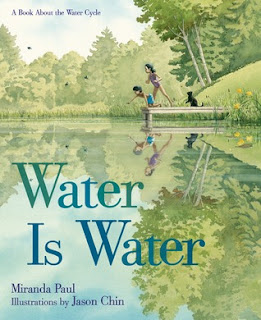We’re about to head into Songkran break here which is around a holiday that involves a LOT of water. I thought it would be a great time to have a Brainstorm on books that teach about the properties of water and/or the water cycle. Click on the titles to see my full review and any content notes.
A Drop of Water by Walter Wick
A survey of the properties and states of water, illustrated with photographs of each. A clearly written and stunningly photographed introduction to the properties and states of water. It’s a great resource and is explained simply enough you can use it with a wide age range, from elementary up to high school. And though this is almost 20 years old now, it has aged extremely well. None of the science or photos are dated. If you can only get one book on water, this is the one to get.
Target Readers:
Nonfiction Fans, Curious Readers, Photography Fans, Middle Grade Readers (though as mentioned, it can be used below and above that age range)
Hey, Water! by Antoinette Portis
A poetic ode to water that introduces little readers to the many places it can be found and forms it takes. The back of the book includes further information about water's properties, states, why it is a precious commodity, and the water cycle. This is the shortest and simplest of all the books in today's Brainstorm.
Target Readers:
Nonfiction Fans, Curious Readers, Readers with Short Attention Spans, Picture Book Readers
Raindrops Roll by April Pulley Sayre
Close-up photographs and rhyming text illuminate raindrop activities before and after rain. Further notes in the back of the book dig deeper into the science of water.
Target Readers:
Rhyming Book Fans, Poetry Fans, Nonfiction Fans, Curious Readers, Photography Lovers, Picture Book Readers
The Rhythm of the Rain by Grahame Baker-Smith
A lyrical look at the water cycle through the eyes of a boy wondering where his jar of water went that he poured into a stream. Gorgeous illustrations!
Target Readers:
Curious Readers, Realistic Fiction Fans, Art Lovers, Picture Book Readers
River by Elisha Cooper
A lone woman loads her canoe and sets off from a lake high in the Adirondack mountains to paddle down the Hudson to the ocean.
An incredibly well-researched book that follows the path of water from high in the mountains to the ocean, and accurately represents the changing landscape beside the bodies of water along the way.
Target Readers:
Canoers, Adventure Fans, Realistic Fiction Fans, New England Setting Fans, Art Lovers, Picture Book Readers
Song of the River by Joy Cowley, ill. by Kimberly Andrews
A mountain boy asks his grandfather what the sea is like. Grandfather promises to some day take him, but one day the trickle of water sings to the boy about the sea. The boy follows the song and finds the sea eventually.
Kimberly Andrews' illustrations for this story are amazing. They really make you feel like you've taken a trip to the woods. Readers also get to learn how the mountain waters eventually make their way to the ocean.
Target Readers:
Nature Story Fans, Grandparent/Grandchild Story Fans, Art Lovers, Picture Book Readers
Water Is Water by Miranda Paul, ill. by Jason Chin
Follow some children as they observe water changing forms throughout the seasons, and even being used by plants and their own bodies.
This book breaks the science down in ways kids can easily grasp, and does so in poetic language and beautiful illustrations. The author's notes in the back of the book provide more scientific terms and explanations for the stages of water in the water cycle.
Target Readers:
Nonfiction Fans, Curious Readers, Poetry Fans, Art Lovers, Picture Book Readers
Wild Weather: Storms, Meteorology, and Climate (Science Comics) by M.K. Reed, ill. by Jonathan Hill
Through the setup of a weather man in a news studio talking to the other anchors, readers will learn what causes all sorts of weather events from rain to hail to jet streams to tornadoes. (And along the way covers the water cycle and forms of water.)
It's hard to classify the books in this Science Comics graphic novel series. Are they educational fiction with the premise given or just entertainingly presented nonfiction? Either way, they do a superb job of teaching the science (and usually go to AP level depths). Secondary science teachers covering weather totally could use this to replace textbook content. And thanks to the graphic novel format, tweens and teens pick them up to read for fun too!
Target Readers:
Graphic Novel Fans, Educational Fiction Fans, Entertaining Nonfiction Fans, Storm Story Fans, Curious Readers, Middle Grade/Young Adult Readers








No comments:
Post a Comment
Polite and respectful comments are welcome.